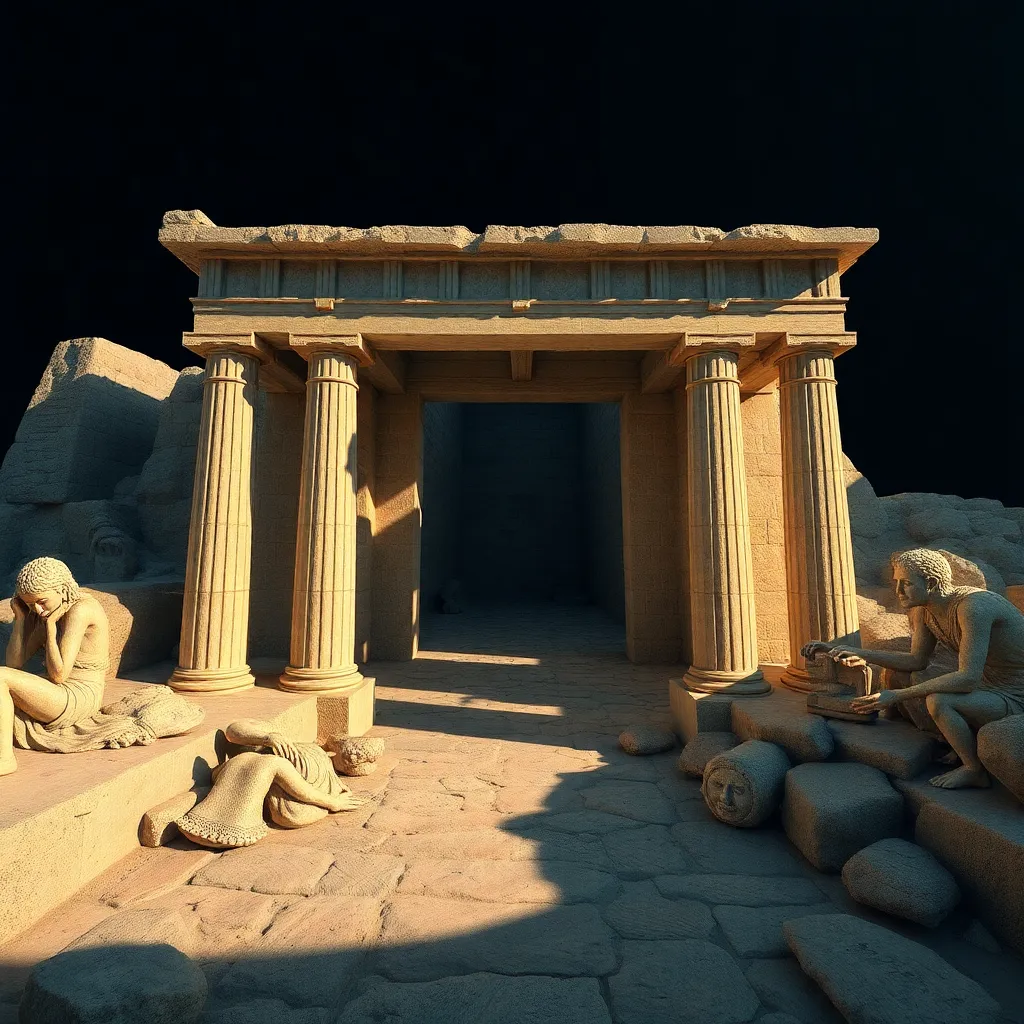The Underworld in Archaeological Discoveries: Insights from Ancient Greece
I. Introduction
The Underworld, known as Hades in Ancient Greek mythology, is a complex and multifaceted realm that represents the afterlife and the final resting place of souls. It is often depicted as a shadowy place where the spirits of the deceased dwell, governed by the god Hades and his queen, Persephone.
The Underworld holds considerable significance in Greek culture and belief systems. It reflects the ancient Greeks’ understanding of life, death, and what lies beyond, influencing their rituals, art, and societal norms. This article aims to explore the archaeological findings that illuminate our understanding of the Underworld, examining how these discoveries align with mythological narratives and ancient practices.
II. Mythological Context of the Underworld
In Greek mythology, the Underworld is not merely a place of punishment but a realm of shadows where all souls go after death. Hades, the god of the Underworld, plays a crucial role in this domain, overseeing the deceased and ensuring the balance between the living and the dead.
Several key figures are associated with the Underworld, including:
- Hades: The ruler of the Underworld, often depicted as stern and unyielding.
- Persephone: The queen of the Underworld, who spends part of the year with Hades and part with her mother, Demeter, on the surface.
- Charon: The ferryman who transports souls across the river Styx, charging a fee typically paid with an obol, a small coin placed in the mouth of the deceased.
The afterlife’s significance in ancient Greek society cannot be understated. It influenced their funeral practices, beliefs about immortality, and the moral values of the living, emphasizing the importance of honoring the dead.
III. Archaeological Sites Linked to the Underworld
Numerous archaeological sites throughout Greece provide valuable insights into the beliefs and practices surrounding the Underworld.
A. Overview of significant archaeological locations
- The Necropolis of Athens: This vast burial site contains thousands of graves and offers a glimpse into the funerary customs of the ancient Athenians.
- The Tomb of Agamemnon at Mycenae: A monumental structure that reflects the burial practices of Mycenaean royalty, complete with lavish artifacts and offerings.
- The Sanctuary of Hades at Ephesus: A site dedicated to the worship of Hades, showcasing rituals and offerings made to the god of the Underworld.
These sites reveal much about the burial practices and beliefs regarding death and the afterlife in ancient Greece, ranging from simple graves to elaborate tombs filled with rich offerings.
IV. Material Culture and the Underworld
Artifacts discovered in archaeological sites related to the Underworld shed light on how the ancient Greeks viewed death and the afterlife.
A. Artifacts associated with death and the afterlife
Common artifacts include:
- Funerary vases: Often intricately decorated, these vases were used to hold offerings or the ashes of the deceased.
- Grave goods: Items such as jewelry, weapons, and tools were placed in graves to accompany the deceased in the afterlife.
- Inscriptions: Many tombs feature inscriptions that honor the deceased, reflecting their status and achievements.
The role of pottery, inscriptions, and iconography is crucial in understanding beliefs about the Underworld, as these items often depict scenes from mythology and provide context for the afterlife’s significance.
V. Rituals and Practices Related to the Underworld
Ancient Greek funerary customs were deeply intertwined with beliefs about the Underworld.
A. Examination of ancient Greek funerary customs
Funerary practices typically included:
- Washing and dressing the body.
- Holding a wake to mourn the deceased.
- Conducting a procession to the burial site.
The significance of sacrifices and offerings to the deceased was paramount, as these acts were believed to ensure a safe passage to the Underworld and favor from the gods.
B. Festivals and ceremonies honoring the dead
One notable festival was the Anthesteria, a three-day celebration honoring the dead, which included:
- Offering wine to the spirits of the deceased.
- Rituals meant to appease the souls and ensure they did not return to haunt the living.
- Feasting and communal gatherings to celebrate life and death.
VI. Literary References and Their Archaeological Correlations
Ancient Greek literature provides rich descriptions of the Underworld and its inhabitants, which correlate with archaeological findings.
A. Analysis of key texts from ancient Greek literature
- Homer’s “Odyssey”: The epic journey of Odysseus includes a descent into the Underworld, providing a vivid depiction of its landscape and inhabitants.
- Virgil’s “Aeneid”: Offers insights into Roman interpretations of the Greek Underworld, reflecting continuity and change in beliefs.
These literary depictions often align with archaeological evidence, such as the types of offerings and burial practices found at various sites.
VII. The Evolution of Underworld Beliefs Over Time
Beliefs about the Underworld evolved from the Archaic to the Hellenistic periods, influenced by cultural exchanges and philosophical developments.
A. Changes in perceptions of the Underworld
Initially viewed as a dark and gloomy realm, the Underworld’s image became more nuanced over time, with ideas of reward and punishment emerging, influenced by other cultures such as the Egyptians.
B. Influence of other cultures on Greek beliefs about the afterlife
Interactions with Eastern cultures introduced new concepts of the afterlife, leading to a more complex understanding of death and resurrection.
C. Contemporary interpretations of ancient beliefs
Modern archaeological findings continue to reinterpret ancient beliefs, providing fresh perspectives on how the Greeks understood death and the afterlife.
VIII. Conclusion
In summary, archaeological discoveries have significantly enhanced our understanding of the Underworld in ancient Greek mythology. From burial practices to material culture, each finding reveals insights into the beliefs and customs surrounding death.
The lasting impact of these ancient beliefs is evident in modern interpretations of death and the afterlife, illustrating how the past continues to shape contemporary thought. As research in archaeology progresses, further discoveries will undoubtedly enrich our understanding of the Underworld and its place in ancient Greek life.




